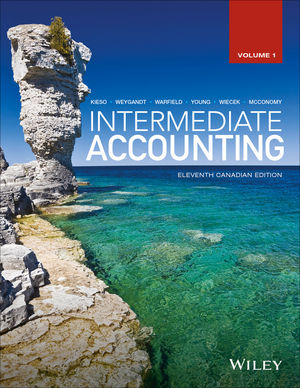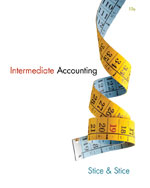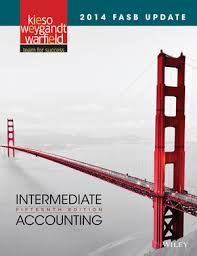Description
Test Bank For Intermediate Accounting Volume 1, 11th Canadian Edition by Bruce Donald E. Kieso
CHAPTER 3
THE ACCOUNTING INFORMATION SYSTEM & MEASUREMENT ISSUES
CHAPTER LEARNING OBJECTIVES
1. Understand basic accounting terminology and explain double-entry rules. It is important to understand the following terms: (1) event, (2) transaction, (3) account, (4) permanent and temporary accounts, (5) ledger, (6) journal, (7) posting, (8) trial balance, (9) adjusting entries, (10) financial statements, (11) closing entries, and (12) reversing entries.
The left side of any account is the debit side; the right side is the credit side. All asset and expense accounts are increased on the left or debit side and decreased on the right or credit side. Conversely, all liability and revenue accounts are increased on the right or credit side and decreased on the left or debit side. Shareholders’ equity accounts, Common Stock, and Retained Earnings are increased on the credit side, whereas Dividends is increased on the debit side.
2. Explain how transactions affect the accounting equation. In a double-entry accounting system, for every debit there must be a credit, and vice versa. This leads us to the basic accounting equation for corporations: Assets = Liabilities + Shareholders’ Equity. The effect of individual transactions on the statement of financial position can be explained using the basic accounting equation. The shareholders’ equity portion of the equation can also be expanded to illustrate the effect of transactions on components of equity such as common shares and retained earnings. Whenever a transaction occurs, the elements of the equation change, but the equality of the two sides of the equation remains unaffected.
3. Identify the steps in the accounting cycle and the steps in the recording process. The basic steps in the accounting cycle are (1) identification and measurement of transactions and other events, (2) journalizing, (3) posting, (4) the unadjusted trial balance, (5) adjustments, (6) the adjusted trial balance, (7) statement preparation, and (8) closing. The first three steps in the accounting cycle form the basis of the recording process used by most medium-sized companies on a daily basis. The simplest journal form is a chronological listing of transactions and events that are expressed as debits and credits to particular accounts. The items entered in a general journal must then be transferred (posted) to the general ledger.
To help prepare financial statements, an unadjusted trial balance should be prepared at the end of a specific period (usually a month, quarter, or year) after the entries have been recorded in the journals and posted to the general ledger.
4. Explain the reasons for and prepare adjusting entries. Adjustments achieve a proper matching of revenues and expenses, which is needed to determine the correct net income for the current period and to achieve an accurate statement of the end-of-the-period balances in assets, liabilities, and owners’ equity accounts. When preparing adjusting journal entries, you must first determine how the original transaction was recorded. For example, was an asset created earlier in the fiscal year (such as prepaid rent) when the initial payment was made? If so, an adjustment for the related expense is required. Alternatively, if a statement of comprehensive income account was used initially, an adjustment may be required to set up the proper statement of financial position account at the end of the period.
5. Explain how the type of ownership structure affects the financial statements. The type of ownership structure that a business enterprise uses determines the types of accounts that are part of the equity section. In a corporation, ordinary or common shares, contributed surplus, retained earnings, and accumulated other comprehensive income are commonly shown separately on the statement of financial position. In a proprietorship or partnership, a capital account is used to indicate the investment in the company by the owner(s). A drawings or withdrawal account may be used to indicate withdrawals by the owner(s). These two accounts are grouped or netted under owners’ equity.
6. Prepare closing entries and consider other matters relating to the closing process. In the closing process, all of the revenue and expense account balances (income statement items) are transferred to a clearing account called Income Summary, which is used only at the end of the fiscal year. Revenues and expenses are matched in the Income Summary account. The net result of this matching, which represents the net income or net loss for the period, is then transferred to a shareholders’ equity account (Retained Earnings for a corporation and capital accounts for proprietorships and partnerships). Reversing entries may be used for reversing accrued revenues and accrued expenses. Prepayments may also be reversed if the initial entry to record the transaction is made to an expense or revenue account.
7. Use valuation techniques to measure financial statement elements. IFRS and ASPE incorporate a mixed-attribute measurement model including measurements that are cost-based (such as historical cost), those that are based on current value (such as fair value), and many hybrid measures that have attributes of both cost-based and current value measurements. Valuation techniques are used to help with measurement of financial statement elements. Common examples include market models and income models. Income models are widely used and include discounted cash flow methods and present value concepts. When using models, you must determine what inputs should be used. Common inputs include discount rates and cash flow estimates. The quality of these inputs affects the quality of the final measurement. Accountants often use probabilities to help deal with risk and uncertainty.
8. Use IFRS 13 to measure fair value. IFRS 13 establishes a fairly detailed body of knowledge relating to measurement of fair value. Fair value measurement under IFRS 13 is a market-based approach that incorporates the specific attributes of the asset/liability being measured, the valuation premise (how the asset/liability is to be used), the principal market, and the valuation technique. Since market prices are not always available, valuation models are used to measure the value. Inputs to these models are either observable in the market or not. Observable inputs are most useful since they are more objective. The fair value hierarchy establishes three levels of inputs, with level 1 being the highest and best type of input (based on observable market prices). Because level 3 inputs are more subjective, additional disclosures are required.
9. Identify differences in accounting between ASPE and IFRS, and what changes are expected in the near future. The main difference is that IFRS contains specific guidance
in IFRS 13 regarding fair value measurements. Under ASPE, guidance is spread throughout the body of knowledge and is less detailed.
10. Prepare a 10-column work sheet and financial statements (Appendix 3A). The 10-column work sheet provides columns for the first trial balance, adjustments, adjusted trial balance, statement of comprehensive income, and statement of financial position. The work sheet does not replace the financial statements. Instead, it is the accountant’s informal device for accumulating and sorting the information that is needed for the financial statements.
11. Understand and apply present value concepts (Appendix 3B). Present value concepts are used to acknowledge the time value of money. There are various techniques and tools to calculate present value, including formulas, tables, financial calculators, and spreadsheets. Inputs to the calculation include interest, payments, number of periods, and if the calculation involves an annuity, information about whether it is an ordinary annuity or an annuity due. Present value concepts are frequently used in measuring financial statement elements.
Multiple Choice QUESTIONS—Conceptual
Answer No. Description
d1.Purpose of an accounting system
b2.Definition of transaction
d3.Purpose of an accounting system
b4.Identification of a temporary account
d5.Accounting equation
a6.Accounting equation
a7.Criteria for recording transactions
c8.Internal event
b9.Definition of journal
c10.Impact of transaction on the accounting equation
d11.Transaction analysis
c12.Transaction analysis
c13.Event recording
c14.Double-Entry Accounting System
c15.Event recording
b16.Trial balance
d17.Trial balance
c18.Trial balance
d19.Uses of adjusting entries
c20.Adjusting for accrued expenses
d21.Adjusting for accrued revenues
d22.Adjusting entries
c23.Factors to consider in estimating depreciation
b24.Contra-asset account
a25.Effect of not recording depreciation
c26.Adjusting for bad debts
c27.Definition of accrued revenue
b28.Closing process
c29.Closing process
c30.Balance Sheet
c31.Closing process
b32.Definition of unearned revenue
c33.Closing process
a34.Fair value adjustments for investments
d35.Closing process
c36.Closing net income or loss
b37.Post-closing trial balance
a38.Trial balance – correct statement
a39.Effect of understating ending inventory
a40.Discounted Cash Flow approach
a41.Fair value measurement under IFRS 13
d42.Fair value measurement under IFRS 13
c43.Differences in accounting between ASPE and IFRS
a44.Differences in accounting between ASPE and IFRS
Multiple Choice QUESTIONS—Computational
Answer No. Description
c45.Adjusting entry for prepaid lease
a46.Adjusting entry for interest receivable
c47.Adjusting entry for interest expense
d48.Adjusting entry for bad debts
b49.Adjusting entry for bad debts
b50.Adjusting entry for unearned rent
c51.Adjusting entry for interest receivable
d52.Calculate property tax adjustment
c53.Calculate balance in unearned revenue
c54.Adjusting entry for investments
d55.Adjusting entry for investments
c56.Calculate cash received for interest
a57.Calculate cash paid for salaries
c58.Calculate cash paid for insurance
c59.Calculate insurance expense
a60.Calculate interest revenue
b61.Calculate salary expense
c62.Valuation of entity-specific asset
c63.Calculate accrued interest payable
c64.Calculate balance of unearned revenues
b65.Calculate prepaid insurance
c66.Calculate interest receivable
c67.Calculate accrued salaries
c68.Calculate royalty revenue
c69.Closing entry
b*70.Calculate present value
a*71.Calculate present value
*This topic is dealt with in an Appendix to the chapter.
Exercises
Item Description
E3-72Definitions
E3-73The accounting cycle
E3-74Adjusting entries
E3-75Recordable events
E3-76Adjusting entries
E3-77Calculation of expense
E3-78Adjusting and Closing Entries
E3-79Valuation of Equipment under IFRS 13
E3-80Calculation of expense
E3-81Calculation of revenue
E3-82Type of ownership structure
E3-83Valuation of Entity-Specific assets
E3-84Measurement of financial statement elements
E3-85Transaction journal entries
E3-86Adjusting entries
*E3-87Calculate market price of a bond
*E3-88Present value of an annuity due
PROBLEMS
Item Description
P3-89Adjusting entries and calculation of pre-tax income
P3-90Adjusting entries
P3-91Adjusting and closing entries
P3-92Closing entries
P3-93Accrual accounting
P3-94Accrual accounting
*P3-95Adjusting entries
P3-96Trial balance correction
P3-97Accrual accounting
P3-98Ten-column work sheet
*P3-99Preparation of financial statements
*This topic is dealt with in an Appendix to the chapter.





Be the first to review “Test Bank For Intermediate Accounting Volume 1, 11th Canadian Edition by Bruce Donald E. Kieso”